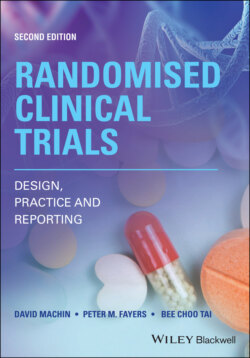Читать книгу Randomised Clinical Trials - David Machin - Страница 46
Example 2.1 Two‐group parallel design – symptomatic oral lichen planus
ОглавлениеPoon, Tin, Kim, et al. (2006) describe a randomised trial of the comparative effect of the then current Standard, topical steroid (S), and the Test, topical cyclosporine (C), in patients with systematic oral lichen planus. The basic structure of their trial is given in Figure 2.1.
This trial typifies the design and structure of the randomised parallel‐group comparative trial which is used extensively. The key features include the following: defining the general types of subjects to be studied, identifying the particular subjects eligible for the trial and obtaining their consent, randomly allocating the Standard and Test interventions to individuals and, once the intervention is introduced, making the appropriate assessments in order to determine outcome. The analysis of the data recorded for all patients will form the basis of the comparison between the intervention groups and (hopefully) provide a clear indication of their relative clinical importance and supply the framework for the subsequent clinical report describing the results.
In the following sections, we will follow the sequence of Figure 2.1 even though this will not be entirely reflected in real‐life situations of the planning stages where a back and to process is more likely. In general, there will also be additional and trial‐specific steps that one must also make.
Figure 2.1 Individually randomised controlled trial of the effect of topical steroid (S) and topical cyclosporine (C) in patients with symptomatic oral lichen planus.
Source: Based on Poon, Goh, Kim, et al., (2006).
